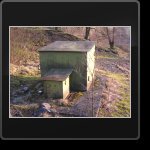Stanhopeburn
Mine was first worked for lead ore and has a long history of being worked by
many different companies. The earliest records show that it was first worked by
the London Lead Company and then by Lord Carlisle in the early to late 18th
century. It was during this period that Clint's and the Lord Carlisle's Water
Level's were driven to work the Crawley and Rippon Veins.
The London
Lead Company acquired a lease again at the beginning of the 19th century and
they developed the Widley Water Level. At the same time the Shield Hurst Level
was being driven by a small partnership. The Shield Hurst Level was following
one of the minor trending veins of the same name and eventually it broke into
the Red Vein in around 1820. Further development of the Widley Water Level saw
the sinking of a shaft to the Low Level extending the workings to the Three
Yard Limestone.
In 1866 the lease passed to The Beaumont Company and
they drove the Shield Hurst Level westwards until strong materialisation was
encountered, mostly working in and above the Great Limestone. Concentrates of
lead ore were poor but they did discover a lot of rich fluorspar bearing
ground, however this was of no interest to them. Finally in 1879 the Beaumont
Company stopped operations.
At the beginning of the 20th century in 1906
the Weardale Lead Company opened the mine again and started extracting the
fluorspar proved by the Beaumont's. Most of the spar came from in or above the
Great Limestone, but some workings did reach the Firestone Sill and below the
Great Limestone. During this period the mine became the leading fluorspar
producer in the area, however the spar produced was not of the highest grade
due to the simple gravity plants used. This ultimately caused production to
decrease and by 1937 it had stopped. The mine briefly opened again between 1939
and 1940 and was operated by a local company, Beaston and Elliot.
At the
start of the 1940's economical conditions were favourable and the mine was
taken over by the newly formed Fluorspar Ltd to produce metallurgical and acid
grade spar. Most of the reserves above the Shield Hurst Level at this point
were exhausted and their attention turned to the lower levels. Widley Water
Level was refurbished as it had collapsed, so that the lower workings could be
drained. A new shaft was sunk at the west end of the Shield Hurst Level where a
new bottom level called Poole's Level was driven, which eventually connected
with the Widley Water Level. Fluorspar Ltd operated the mine until 1964 and
then Laporte Chemicals Ltd took over who considered it was not worthwhile to
carry on operations and closed the mine down.
In 1971 Ferguson Wild and
Company Ltd started to work the mine and they refurbished the Widley Water
Level and the new shaft in the west end of the Shield Hurst Level. However,
before any significant production could be started Swiss Aluminium UK took over
the lease. Swiss Aluminium UK undertook an ambitious program to help increase
the production and output from the mine. The Shield Hurst Level was
straightened and the underground shafts refurbished so that ore could be
extracted and brought to the surface more easily. The depth of the workings was
extended as far as the Tynebottom Limestone, but much of the fluorspar
extracted came from the old London Lead Company stopes. After 1982 and the
onset of the collapse of the fluorspar market Swiss Aluminium UK stopped
working the mine and it was taken over by a subsidiary of Minworth, a
Derbyshire company. No further working was carried out and the main level was
closed.
|
